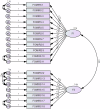Development and psychometric evaluation of the fear of medical imaging radiation scale (FOMIRS): insights from multimethod analysis
- PMID: 40579622
- PMCID: PMC12205105
- DOI: 10.1186/s13244-025-02018-1
Development and psychometric evaluation of the fear of medical imaging radiation scale (FOMIRS): insights from multimethod analysis
Abstract
Objective: Fear of medical imaging radiation (FOMIR) may influence disease screening willingness; however, no validated tool currently exists to assess FOMIR. This study aimed to develop and validate the Fear of Medical Imaging Radiation Scale (FOMIRS) and explore its psychological mechanisms.
Methods: Based on classical test theory, the FOMIRS was developed through semi-structured interviews, grounded theory, and Delphi consultation. A cross-sectional survey with 1509 participants was conducted in Yunnan Province from September to December 2024. Psychometric properties were evaluated using construct validity, convergent validity, discriminant validity, criterion-related validity, content validity, and internal consistency. ROC curve analysis was used to determine the critical thresholds. Logistic regression analysis, network analysis, and structural equation modeling were employed to examine the relationships between the FOMIRS and related variables.
Results: The FOMIRS consisted of 18 items organized into a two-dimensional structure. It demonstrated good model fit (Goodness-of-fit index = 0.909, Comparative fit index = 0.949), convergent validity (AVE > 0.45, CR > 0.80), discriminant validity (HTMT = 0.574), criterion-related validity (γ = 0.441), and content validity (S-CVI = 0.889). The FOMIRS also showed excellent internal consistency (Cronbach's α = 0.926 and McDonald's ω = 0.935). Cost-induced refusal of imaging examinations, cancer screening willingness, online learning, imaging radiation cognition, and fear of cancer were identified as influencing factors of FOMIR (p < 0.05). FOMIR serves as a core node in the network, and imaging radiation cognition may affect cancer screening willingness through this mechanism (p < 0.05).
Conclusion: FOMIRS accurately measures individual FOMIR levels. It captures the psychological characteristics and behavioral tendencies associated with FOMIR and indicates potential mechanisms.
Critical relevance statement: We developed the Fear of Medical Imaging Radiation Scale (FOMIRS), a psychometric tool measuring individuals' fear of medical imaging radiation (FOMIR), demonstrating good reliability, validity, and practical application potential.
Key points: Evaluating individuals' FOMIR improves compliance with imaging exams and reduces related cognitive biases. FOMIRS is a reliable and valid tool for measuring FOMIR levels, capturing psychological and behavioral traits, and revealing interactions with external features. FOMIR is a complex phenomenon involving psychological traits, behavioral tendencies, and cognitive biases that affect people's willingness to undergo cancer screening.
Keywords: Fear of medical imaging radiation; Mechanisms; Reliability; Scale; Validity.
© 2025. The Author(s).
Conflict of interest statement
Declarations. Ethics approval and consent to participate: The study protocol received approval from the Ethics Committee of the Sixth Affiliated Hospital of Kunming Medical University (Approval No. 2024 kmykdx6f014). This investigation was executed fully with the Declaration of Helsinki and within the authorization’s validity period. Participants were not offered any form of compensation to encourage their involvement in the study. The questionnaire design meticulously avoided questions perceived as discriminatory or offensive, ensuring it did not provoke physical discomfort or psychological stress among respondents. Consent for publication: At the beginning of the survey, participants were presented with an informed consent document, and they had to electronically sign a consent form before proceeding with the questionnaire. Individuals had the right to withdraw from the research without any penalty. No personal data such as names, contact information, residential or employment addresses were collected to protect participant anonymity and confidentiality. Competing interests: The authors declare that they have no competing interests.
Figures





Similar articles
-
Psychometric properties of the Chinese version of the pros and cons of anorexia nervosa (P-CAN-C) scale: a validation study in patients with anorexia nervosa.J Eat Disord. 2025 Jun 16;13(1):111. doi: 10.1186/s40337-025-01314-x. J Eat Disord. 2025. PMID: 40524259 Free PMC article.
-
Cost-effectiveness of using prognostic information to select women with breast cancer for adjuvant systemic therapy.Health Technol Assess. 2006 Sep;10(34):iii-iv, ix-xi, 1-204. doi: 10.3310/hta10340. Health Technol Assess. 2006. PMID: 16959170
-
A systematic review of tools designed for teacher proxy-report of children's physical literacy or constituting elements.Int J Behav Nutr Phys Act. 2021 Oct 8;18(1):131. doi: 10.1186/s12966-021-01162-3. Int J Behav Nutr Phys Act. 2021. PMID: 34620185 Free PMC article.
-
Italian validation of the credibility/expectancy questionnaire in spinal pain: a useful tool for clinicians and physiotherapist (CEQ-I).Ther Adv Chronic Dis. 2025 Jun 21;16:20406223251324812. doi: 10.1177/20406223251324812. eCollection 2025. Ther Adv Chronic Dis. 2025. PMID: 40546309 Free PMC article.
-
Psychometric Evaluation of the Persian Version of the Professional Socialization Scale for Hospital Nurses: A Methodological Study.SAGE Open Nurs. 2025 Jun 19;11:23779608251345276. doi: 10.1177/23779608251345276. eCollection 2025 Jan-Dec. SAGE Open Nurs. 2025. PMID: 40546805 Free PMC article.
References
-
- Hauptmann M, Byrnes G, Cardis E et al (2023) Brain cancer after radiation exposure from CT examinations of children and young adults: results from the EPI-CT cohort study. Lancet Oncol 24:45–53 - PubMed
-
- Angelidis G, Tsougos I, Valotassiou V, Georgoulias P (2020) Low-dose radiation cancer risk hypothesis may lead to ‘radiophobia’-driven imaging avoidance. J Nucl Cardiol 27:1050 - PubMed
-
- Lindberg JCH (2021) ‘J’accuse.!’: the continuous failure to address radiophobia and placing radiation in perspective. J Radiol Prot. 10.1088/1361-6498/abf9e2 - PubMed
Grants and funding
LinkOut - more resources
Full Text Sources

